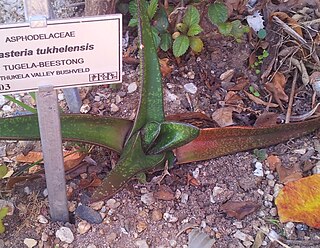
Haworthia is a large genus of small succulent plants endemic to Southern Africa (Mozambique, Namibia, Lesotho, Eswatini and South Africa).

Gasteria is a genus of succulent plants, native to South Africa and the far south-west corner of Namibia.

Gasteria excelsa is a succulent plant, native to the Eastern Cape Province, South Africa.

Aloe ferox, commonly known as bitter aloe, is a species of flowering plant in the family Asphodelaceae. This woody aloe is indigenous to southern Africa. It is one of several Aloe species used to make bitter aloes, a purgative medication, and also yields a non-bitter gel that can be used in cosmetics.

Gasteria armstrongii is a dwarf succulent plant native to South Africa, in the genus Gasteria.

Haworthia mirabilis is a species of the genus Haworthia belonging to the family Asphodelaceae.

Aloe reynoldsii is a species of plant in the Asphodelaceae family.

Crassula capitella, is a perennial succulent plant native to southern Africa.

Aloe pluridens is an arborescent aloe indigenous to southern Africa.

Aloe rupestris is an arborescent aloe indigenous to summer-rainfall areas of southern Africa.

Gasteria bicolor is a species of succulent flowering plant in the family Asphodelaceae, native to the Eastern Cape, South Africa.

Gasteria nitida, the Bathurst gasteria, is a succulent plant, native to the Eastern Cape grasslands of South Africa.

Gasteria carinata is a small and variable succulent plant, native to the Western Cape Province, South Africa.

Gasteria brachyphylla is succulent plant native to the Western Cape, South Africa.

Gasteria croucheri is a succulent plant, native to KwaZulu-Natal Province, South Africa.

Gasteria tukhelensis is a species of succulent plant, native to the Tugela River valley, in KwaZulu-Natal Province, South Africa.

Gasteria baylissiana, Suurberg gasteria, is a species of succulent flowering plant in the family Asphodelaceae, native to the Eastern Cape, South Africa.

Gasteria glauca, the Kouga gasteria, is a succulent plant, native to the cliffs above the Kouga river, in the Eastern Cape, South Africa.

Gasteria pulchra is a succulent plant, restricted to a locality in the Albany thickets vegetation of the Eastern Cape, South Africa.

Gasteria polita, the polished gasteria, is a recently discovered succulent plant, restricted to a locality in the Afro-temperate forest of the Western Cape, South Africa.





















